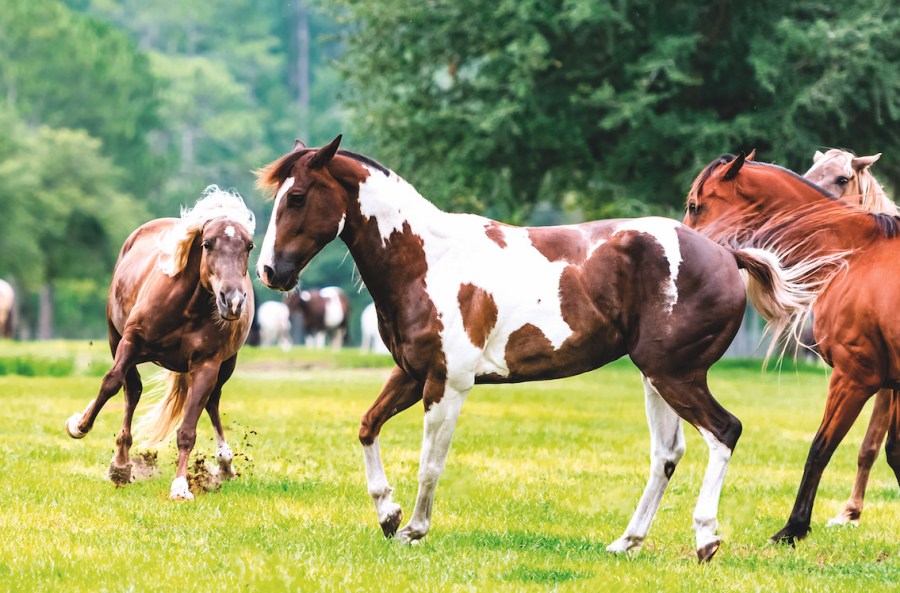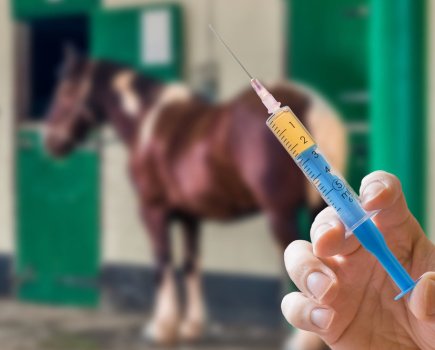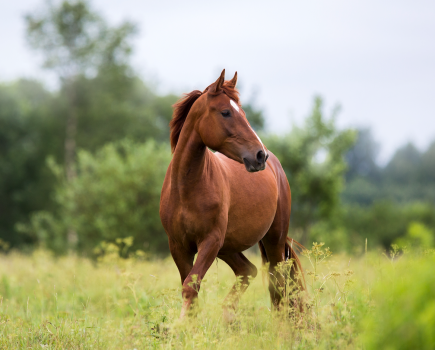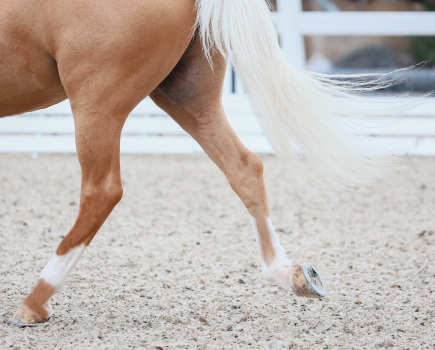Wounds in horses are unfortunately extremely common and every horse owner should be aware of how to deal with them. While many wounds are small and require little more than cleaning and monitoring closely, some inconspicuous-looking wounds can have far more serious consequences than might first appear. Therefore, your wound care knowledge and management skills need to be up to date, with a fully stocked horse first aid kit easily to hand when you need it.
The most common wounds occur on horse’s limbs and are caused by foreign objects such as fences, gates, farm implements and building materials. Wounds on the distal (lower) limbs of horses can be especially difficult to manage because of poor circulation, joint movement and minimal soft tissue between skin and bone.
There is also always the risk of contamination from the environment. The smallest most innocuous looking cut or puncture wound can sometimes present a serious problem that may require surgery. Conversely, a wound that initially looks large and severe may require little veterinary attention.
Four types of wound
1 Puncture wounds
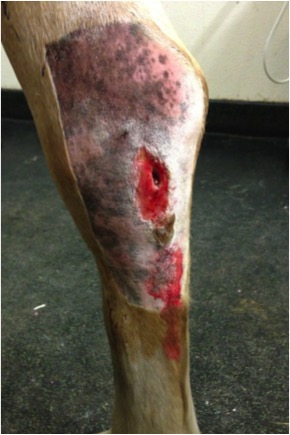
Puncture wound: this horse was kicked to the inside of the hock, close to the tarsal sheath, and was admitted to Rossdales Equine Hospital for treatment
These may look small on the surface, but there may be significant damage beneath the skin surface. This type of wound can be complicated by infection, as contamination is introduced deep into the wound.Often the skin heals before the underlying tissue. These wounds should be cleaned, lavaged, and encouraged to drain and remain unsutured.
2 Incised (slicing) wounds
These normally have smooth edges and are suitable for repair by suturing, stapling or gluing.
3 Lacerations
These are wounds that usually leave jagged edges and may cause underlying soft tissue damage and infection. Lacerations may require some debridement (removal of damaged tissue or foreign objects) and are often best managed as open wounds, depending on severity and location.
4 Abrasions
Generally minor wounds, these require cleaning and can be treated topically.
Assessing the wound
If the horse is out in the field, bring it in to the yard or onto a hard surface where the wound isn’t going to become more contaminated. If the horse is distressed or in pain, don’t take risks trying to examine the horse yourself; call a vet who can sedate the horse in order to assess the wound in a safe manner.
It is important to restrain and calm the horse and stem any bleeding with direct pressure and apply a thick gamgee/lint dressing held in place with an elasticated bandage. Assess how comfortable your horse is. If it is lame, call a vet.
When you find a wound, ask yourself two questions:
- Is the wound still bleeding?
- How old is it?
“Look around, because if you can find what’s caused the wound you’ve got a big clue as to possible damage and potential problems during the healing process,” advises Georgie Hollis, who founded the Veterinary Wound Library and Bandaging Angels.
Wound care action plan
Location rather than size is the best indicator of severity, says Georgie. “Anything from the stifle down and all leg wounds, however small, should be taken seriously — especially those over a joint or in the sole of the foot,” she states. “Even a small puncture could have penetrated structures that are extremely hard to treat if infection sets in.”
Call-outs cost money, but early veterinary intervention can save cash and stress in the long run. How your horse reacts to a wound is a good guide as to whether there could be something life-threatening going on, explains equine vet Dr Patrick Pollock MRCVS.
“Thankfully, wounds with underlying fractures form the minority of cases,” he says. “Usually, wounds aren’t particularly painful so a horse that’s non-weight bearing after a wound rings alarm bells and shouldn’t be moved until a vet has seen them.”
Patrick says contaminated joint and sole puncture wounds are much more common, and are often missed or discounted by owners.
“The horse isn’t lame initially, but then 24-hours later the wound has become septic, the horse is non-weight bearing lame and the prognosis has become much worse. Always get your vet’s opinion on these kind of injuries, as quick action could save your horse’s soundness and even his life.”
When to call a vet
The following a reasons to call your vet to assess and treat your horse’s wound as soon as possible:
- If the wound is large or deep or if it is bleeding profusely.
- If the wound is on or near a joint or tendon sheath. These require surgery to flush the joint or sheath with fluids.
- If you think the wound is close to any of these structures, it is better to be safe rather than run the risk of a long-standing infection in a joint which can have serious and expensive consequences.
- If there is a clear, sticky discharge coming from the wound. Call your vet immediately, because it could be synovial fluid from a joint or sheath.
- If your horse is lame.
- The wound might involve a joint or other important structure that will require veterinary attention. There may also be damage to the underlying bone which will be much more serious than the small cut that a kick often leaves on the skin.
- If the horse has been kicked. There are several areas on horses’ legs which are covered with little more than a thin layer of skin. If they are kicked here, there may be a fracture of the underlying bone.
- If the lameness worsens.
- If the wound isn’t healing or gets worse.
- If proud flesh appears within or around the healing wound.
Wounds on or near a joint
Don’t be fooled into thinking that the wound can’t involve a joint, sheath or bursa if your horse is not very lame. An important point with septic joints or tendon sheaths is that it is commonly the swelling (increased intrasynovial pressure) within the joint, tendon sheath or bursa that causes lameness. Therefore, if there is an open wound communicating with a joint, for example, fluid will be leaking out and there will not be any swelling.
Once the synovial lining closes, the joint will swell, and the increased pressure will cause the severe lameness expected with a septic joint. That’s why if your horse incurs a wound that is on or very close to a joint, it is best practice to get your vet to look at it as soon as possible — it’s always better to be safe than sorry.
Wound care at home
If you have followed all this advice and deemed that it is a simple wound you can assess and treat yourself, follow the wound care steps below:
- Wash the wound thoroughly with cold water. This will also help reduce any swelling.
- Mild antiseptic solutions such as Hibiscrub are often used to clean the wound edges, but not deep wounds.
- Copious lavage or irrigation of the wound will wash away visible and microscopic debris and organisms.
- The best solution for irrigation is sterile saline with or without dilute antiseptics.
- If you can do it safely without further injuring the horse — or yourself — clip the hair around the wound. This will help to assess the wound and keep it clean.
- Vets often administer Intrasite® gel into the wound before clipping to avoid contaminating the wound with hair.
- It is important to ensure the wound doesn’t involve a synovial cavity: that is a joint, tendon sheath or bursa. If the wound is large or deep, call your vet — it may require stitching.
Did you know?
Manuka honey can be helpful in some cases to promote wound healing and prevent infection. It’s very important to use medical Manuka honey, as supermarket-bought honey can carry a risk of botulism when applied to wounds. Keep it in your horse first aid kit, ready for when you need to provide wound care to your horse.
Wound care for simple wounds
If the wound looks simple, you are confident that it doesn’t overlie an important structure and the horse is not lame, you can apply a clean dressing. If in doubt, ask your vet to show you how to apply a dressing. Ideally the dressing should be applied with firm pressure, but not too tightly as this can cause serious complications, such as bowed tendons, constriction of the blood supply or restricting return of blood from the area.
If the dressing is too loose, it may not stay in place and could cause rubs. Monitor the wound until it heals fully. If the wound doesn’t seem to be healing well or quickly, there may be a more serious underlying issue which is preventing the wound from healing. If the horse appears to be getting more lame, call a vet; it may be more serious than you first thought.
Allow the wound time to heal if it is large, or if it is obviously being affected by exercise. Movement will delay wound healing, so it will take time to heal if it is large, or if it is obviously being affected by exercise. Movement will delay wound healing, so it will take longer to heal completely which in turn will increase the cost of dressing materials etc. Box rest might be necessary — ask your vet for advice on this.

